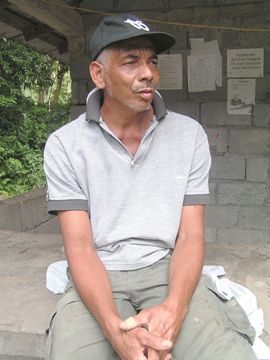Six legged Calf suffers unusual fate

Jamila Soso-Vincent 16.JAN.09
On July 3rd, 2000, Bernard Rodriguez was deep in Locust Mountains preparing for what he thought would be an ordinary delivery – one of his cows was in labour. Instead, the farmer witnessed what was undoubtedly the strangest thing his eyes had ever seen. The cow gave birth to a calf with six legs!{{more}}
In the July 28, 2000, issue of SEARCHLIGHT, Rodriguezâs son, Verrol Ryan, was interviewed about the unusual birth. He had related that the calf (a heifer) was in good health, and the only problem was that the hooves of its extra legs were bruising its left side. Ryan had also predicted that it would live a normal, healthy life.
Enquiring minds must want to know if Ryanâs prediction was accurate. Sadly, he was off the mark. Just 2 weeks after the interview, the calf died from injuries it sustained after being bitten by a neighbourâs donkey. It was cremated because an appropriate place to bury it could not be located.
Speaking to SEARCHLIGHT, Bernard Rodriguez, a South Rivers resident, gave an account of the unforeseen incident that caused the calfâs untimely demise. His neighbourâs donkey had escaped the confines of its rope, wandered onto his property and promptly attempted to âjumpâ the calf.
Naturally, it resisted, and in doing so, received several bites to its hindquarters from the donkey. âAll by its back legs got bite up… all by de tail!â Rodriguez explained. Like any good farmer, Rodriguez tended to the
calfâs wounds by soaking them in a vinegar solution – expecting that it would heal the bites.
However, his efforts were in vain because the wounds were much more serious than he originally thought. âOne week it stand up, and the next week it go on the ground,â he recalled. His vinegar remedy had not been enough to stave off infection, and the calf eventually succumbed to its injuries. In its final week, Rodriguez called in the vet who informed him that the calf was already beyond the point of no return. âIf ah did know it get so much ah bite, I would have called in the vet earlier,â he said with much regret.
Still understandably annoyed, Rodriguez believes that the calf may still have been alive had his neighbour been more thorough in securing his donkey. Officials from the Ministry Of Agriculture had visited the calf and given it a clean bill of health. In particular, Rodriguez missed the calf when the Agricultural Exhibition took place in October 2008. âI could have put it on show!â He pointed out that the calf was robust and had long limbs. âI vex! All now so I could have made some money from de cattle… it could have had a calf…â
When he approached his neighbour seeking compensation for the calf, Rodriguez said he was point blank refused. âDe man turn and tell me if he have to pay for the heifer, me have to take him to Court!â Rodriguez complained. He had all intentions of doing just that, but his hopes were dashed when the man who had seen the incident refused to give evidence in Court. âSo he get away,â the farmer sighed. âI just leave it at that…â
According to Chief Veterinary Officer Dr. Kathian Hackshaw, such defects (extra limbs) are referred to as genetic dysfunctions, and are caused by incomplete division during mitosis. Simply put, the calf may well have been the result of fraternal twins that fused during development in the womb. This could be attributed to a number of reasons, including poor nutrition during the gestation period. Such animals are often plagued with internal problems and donât usually have a long life span. âThey donât survive very long,â Dr. Hackshaw stated.
She further noted that livestock with such defects sometimes have weakened immune systems, and this may well have been why the calf was unable to fight off the infection. However, Dr. Hackshaw acknowledged that the calf was something of a miracle for living that long. Although she knows of a fair number of cases of animals born with extra limbs, they are usually still born or die very shortly after birth.
So this reporter wonders: just how long would the calf have survived, had it not fallen victim to the attentions of an overly amorous donkey?









